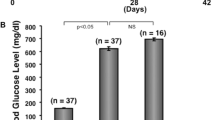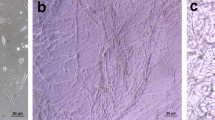Abstract
Aims/hypothesis
Impaired wound healing significantly impacts morbidity and mortality in diabetic patients, necessitating the development of novel treatments to improve the wound healing process. We here investigated the topical use of acellular embryonic stem cell extracts (EXTs) in wound healing in diabetic db/db mice.
Methods
Wounds were induced in diabetic db/db mice, which were subsequently treated with EXTs, with 3T3 fibroblast cell line protein extracts (3T3XTs) or with saline as a control. Pathology and mechanistic assays were then performed.
Results
The in vivo topical administration of EXTs facilitates wound closure, contraction and re-epithelialization. Moreover, EXTs reduced the number of wound-infiltrating CD45+ inflammatory cells and increased the rate of repair and of angiogenesis as compared to controls. Interestingly, the EXT effect was partly enhanced by the use of a collagen-based biocompatible scaffold. In vivo, topical administration of EXTs increased the percentage of regulatory T cells in the wounded tissue, while in vitro EXT treatment reduced T cell-mediated IFN-γ production. Proteomic screening revealed 82 proteins differentially segregating in EXTs as compared to 3T3 extracts, with APEX1 identified as a key player for the observed immunomodulatory effect of EXTs.
Conclusions
EXTs are endowed with immunoregulatory and anti-inflammatory properties; their use improves wound healing in diabetic preclinical models.



Similar content being viewed by others
Availability of data and material
All data generated or analyzed during this study are available from the corresponding author on reasonable request.
References
Boulton AJ, Kirsner RS, Vileikyte L (2004) Clinical practice. Neuropathic diabetic foot ulcers. N Engl J Med 351(1):48–55. https://doi.org/10.1056/nejmcp032966
Zhang P, Lu J, Jing Y, Tang S, Zhu D, Bi Y (2017) Global epidemiology of diabetic foot ulceration: a systematic review and meta-analysis (dagger). Ann Med 49(2):106–116. https://doi.org/10.1080/07853890.2016.1231932
Eming SA, Krieg T, Davidson JM (2007) Inflammation in wound repair: molecular and cellular mechanisms. J Invest Dermatol 127(3):514–525. https://doi.org/10.1038/sj.jid.5700701
Mohib K, AlKhamees B, Zein HS, Allan D, Wang L (2012) Embryonic stem cell-derived factors inhibit T effector activation and induce T regulatory cells by suppressing PKC-theta activation. PLoS ONE 7(3):e32420. https://doi.org/10.1371/journal.pone.0032420
Koch CA, Geraldes P, Platt JL (2008) Immunosuppression by embryonic stem cells. Stem Cells 26(1):89–98. https://doi.org/10.1634/stemcells.2007-0151
Ben Nasr M, Tezza S, D’Addio F et al (2017) PD-L1 genetic overexpression or pharmacological restoration in hematopoietic stem and progenitor cells reverses autoimmune diabetes. Sci Transl Med. https://doi.org/10.1126/scitranslmed.aam7543
D’Addio F, Trevisani A, Ben Nasr M et al (2014) Harnessing the immunological properties of stem cells as a therapeutic option for diabetic nephropathy. Acta Diabetol 51(6):897–904. https://doi.org/10.1007/s00592-014-0603-1
Mounayar M, Kefaloyianni E, Smith B et al (2015) PI3kalpha and STAT1 interplay regulates human mesenchymal stem cell immune polarization. Stem Cells 33(6):1892–1901. https://doi.org/10.1002/stem.1986
Mohib K, Allan D, Wang L (2010) Human embryonic stem cell-extracts inhibit the differentiation and function of monocyte-derived dendritic cells. Stem Cell Rev 6(4):611–621. https://doi.org/10.1007/s12015-010-9185-7
Jt Michaels, Churgin SS, Blechman KM et al (2007) db/db mice exhibit severe wound-healing impairments compared with other murine diabetic strains in a silicone-splinted excisional wound model. Wound Repair Regen 15(5):665–670. https://doi.org/10.1111/j.1524-475X.2007.00273.x
Scherer SS, Pietramaggiori G, Mathews JC, Chan R, Fiorina P, Orgill DP (2008) Wound healing kinetics of the genetically diabetic mouse. Wounds 20(1):18–28
Pietramaggiori G, Scherer S, Orgill DP (2013) The wound watch: an objective staging system for wounds in the diabetic (db/db) mouse model. Methods Mol Biol 1037:245–254. https://doi.org/10.1007/978-1-62703-505-7_13
Julier Z, Park AJ, Briquez PS, Martino MM (2017) Promoting tissue regeneration by modulating the immune system. Acta Biomater 53:13–28. https://doi.org/10.1016/j.actbio.2017.01.056
Fiorina P, Jurewicz M, Tanaka K et al (2007) Characterization of donor dendritic cells and enhancement of dendritic cell efflux with CC-chemokine ligand 21: a novel strategy to prolong islet allograft survival. Diabetes 56(4):912–920. https://doi.org/10.2337/db06-1445
Tombulturk FK, Soydas T, Sarac EY et al (2019) Regulation of MMP 2 and MMP 9 expressions modulated by AP-1 (c-jun) in wound healing: improving role of Lucilia sericata in diabetic rats. Acta Diabetol 56(2):177–186. https://doi.org/10.1007/s00592-018-1237-5
Borys S, Ludwig-Slomczynska AH, Seweryn M et al (2019) Negative pressure wound therapy in the treatment of diabetic foot ulcers may be mediated through differential gene expression. Acta Diabetol 56(1):115–120. https://doi.org/10.1007/s00592-018-1223-y
Rouland A, Fourmont C, Sberna AL et al (2019) Malnutrition in type 2 diabetic patients does not affect healing of foot ulcers. Acta Diabetol 56(2):171–176. https://doi.org/10.1007/s00592-018-1233-9
Lee KB, Choi J, Cho SB et al (2011) Topical embryonic stem cells enhance wound healing in diabetic rats. J Orthop Res 29(10):1554–1562. https://doi.org/10.1002/jor.21385
Fiorina P, Jurewicz M, Vergani A et al (2011) Targeting the CXCR4-CXCL12 axis mobilizes autologous hematopoietic stem cells and prolongs islet allograft survival via programmed death ligand 1. J Immunol 186(1):121–131. https://doi.org/10.4049/jimmunol.1000799
Ben Nasr M, D’Addio F, Malvandi AM et al (2018) Prostaglandin E2 stimulates the expansion of regulatory hematopoietic stem and progenitor cells in type 1 diabetes. Front Immunol 9:1387. https://doi.org/10.3389/fimmu.2018.01387
Ben Nasr M, Vergani A, Avruch J et al (2015) Co-transplantation of autologous MSCs delays islet allograft rejection and generates a local immunoprivileged site. Acta Diabetol 52(5):917–927. https://doi.org/10.1007/s00592-015-0735-y
Ben Nasr M, D’Addio F, Usuelli V, Tezza S, Abdi R, Fiorina P (2015) The rise, fall, and resurgence of immunotherapy in type 1 diabetes. Pharmacol Res 98:31–38. https://doi.org/10.1016/j.phrs.2014.07.004
Giatsidis G, Cheng L, Haddad A et al (2018) Noninvasive induction of angiogenesis in tissues by external suction: sequential optimization for use in reconstructive surgery. Angiogenesis 21(1):61–78. https://doi.org/10.1007/s10456-017-9586-1
Fagher K, Katzman P, Londahl M (2018) Transcutaneous oxygen pressure as a predictor for short-term survival in patients with type 2 diabetes and foot ulcers: a comparison with ankle-brachial index and toe blood pressure. Acta Diabetol 55(8):781–788. https://doi.org/10.1007/s00592-018-1145-8
Akhter N, Takeda Y, Nara H et al (2016) Apurinic/apyrimidinic endonuclease 1/redox factor-1 (Ape1/Ref-1) modulates antigen presenting cell-mediated T helper cell type 1 responses. J Biol Chem 291(45):23672–23680. https://doi.org/10.1074/jbc.M116.742353
Park MS, Choi S, Lee YR et al (2016) Secreted APE1/Ref-1 inhibits TNF-alpha-stimulated endothelial inflammation via thiol-disulfide exchange in TNF receptor. Sci Rep 6:23015. https://doi.org/10.1038/srep23015
Baek H, Lim CS, Byun HS et al (2016) The anti-inflammatory role of extranuclear apurinic/apyrimidinic endonuclease 1/redox effector factor-1 in reactive astrocytes. Mol Brain 9(1):99. https://doi.org/10.1186/s13041-016-0280-9
Acknowledgements
We are thankful to Prof. Nicholas Zavazava (Carver College of Medicine, University of Iowa) for providing embryonic cell extracts. We thank Mollie Jurewicz for editorial assistance. We thank the Fondazione Romeo and Enrica Invernizzi for the extraordinary support.
Funding
Paolo Fiorina is supported by an Italian Ministry of Health Grant RF-2016-02362512 and by Linea-2 2019 funding from Università di Milano. Francesca D’Addio is the recipient of a Società Italiana di Diabetologia (SID) Lombardia Grant and of the EFSD/JDRF/Lilly Programme on Type 1 Diabetes Research 2019. Vera Usuelli is supported by Fondazione Diabete Ricerca (FO.DI.RI) Società Italiana di Diabetologia (SID) fellowship.
Author information
Authors and Affiliations
Contributions
C.L. and M.B.N. designed the study, performed experiments, analyzed data, and wrote the paper; G.G., L.L. and SS.S. performed immunostaining and histological analysis of the wounds; R.B. performed proteomic analysis; F.D., A.VV., L.S., M.M., A.A., E.I., E.A. and V.U. performed experiments and analyzed data; B.EE., A.S., G.P. and GV.Z. coordinated and designed the research and edited the paper; DP.O. designed animal studies and reviewed the manuscript; P.F. conceived the idea, designed the study, and wrote and edited the paper. All authors were given full access to all data presented in this study and are responsible for the integrity of the data and accuracy of the data analysis. All authors have given their permission for submission of this manuscript.
Corresponding author
Ethics declarations
Conflict of interest
The authors declare no present or potential conflicts of interest. This study was performed without the support or involvement of any external funding source or study sponsor in any phase of the investigation, or in the writing or submission of the manuscript.
Human and animal rights disclosure
All procedures performed in the study were in accordance with the ethical standards as laid down in the 1964 Declaration of Helsinki and its later amendments or comparable ethical standards.
Consent to participate
Written informed consent was obtained from all individual participants included in the study.
Code availability
Not applicable.
Additional information
Managed By Massimo Federici.
Publisher's Note
Springer Nature remains neutral with regard to jurisdictional claims in published maps and institutional affiliations.
Electronic supplementary material
Below is the link to the electronic supplementary material.
Rights and permissions
About this article
Cite this article
Loretelli, C., Ben Nasr, M., Giatsidis, G. et al. Embryonic stem cell extracts improve wound healing in diabetic mice. Acta Diabetol 57, 883–890 (2020). https://doi.org/10.1007/s00592-020-01500-0
Received:
Accepted:
Published:
Issue Date:
DOI: https://doi.org/10.1007/s00592-020-01500-0




